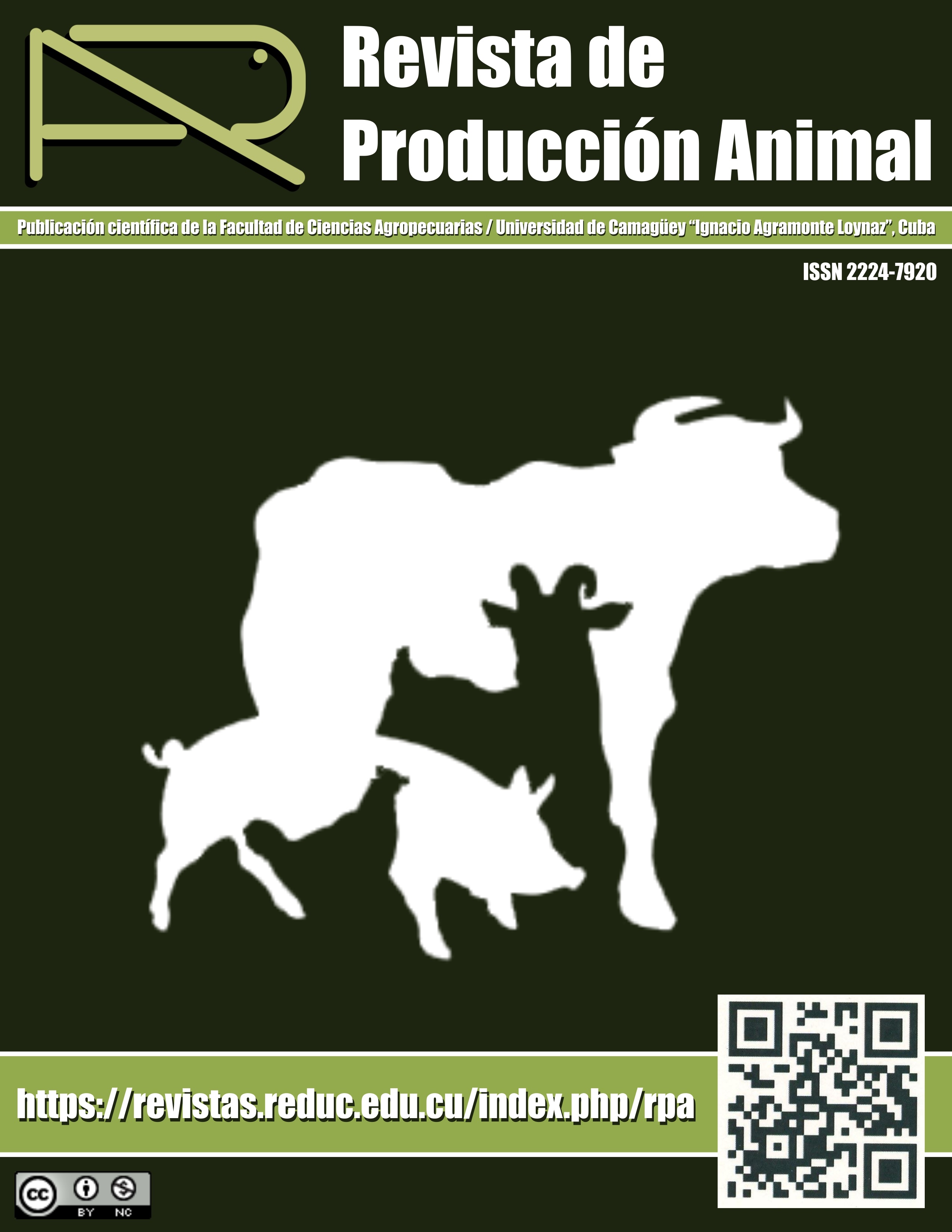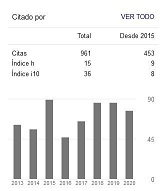Chemical properties and sensory characteristics of wild boar meat (Sus scrofa scrofa) fed with acorns (Quercus robur)
Resumen
Backround: The wild boar (Sus scrofa scrofa) has favourable meat characteristics compared to the domestic pig particularly regarding the fat and cholesterol content. The present study aimed to determine whether the meat of wild boar fed with 20% or 40% acorns in their diet had different chemical properties and sensory meat characteristics.
Methods: A group of six wild boar (Sus scrofa s.) with an initial live weight of 40 kg, received fresh whole Quercus robur acorns at 20% w/w of their daily feedstuff for 60 days, a second group received 40% w/w and a third group consumed commercial feed without acorns (control group). Proximal chemical analysis was performed on the feedstuff, acorns, and meat. Fatty acids and cholesterol in the Longissimus lumborum muscle were measured via gas chromatography.
Results: The meat from the control fatty acid group had a higher composition of C16: 0 fatty acids and cholesterol, and also had a lower proportion of monounsaturated and polyunsaturated fatty acids, and of the n6: n3, P/S ratio, than the acorn-fed wild boar groups.
Conclusions: The meat of wild board fed with acorn had better characteristics in terms of nutritional factors such as the level of monounsaturated fatty acids, polyunsaturated fatty acids, cholesterol, and sensory characteristics.
Key words: animal nutrition; animal feed; essential fatty acids; food composition; meat industry (Source: UNBIS)
Descargas
Citas
Aaslyng, M. D., & Meinert, L. (2017). Meat flavour in pork and beef–From animal to meal. Meat science, 132, 112-117. https://doi.org/10.1016/j.meatsci.2017.04.012
AOAC. (1990). Official method 950.46, Moisture in meat, B. Air drying. In K. Helrich, Official methods of analysis of the association of official analytical chemists (Fifteenth edition, Vol. II) (p. 931). Arlington: Association of Official Analytical Chemists, Inc.
Ayuso, D., González, A., Peña, F., Hernández-García, F. I., & Izquierdo, M. (2020). Effect of fattening period length on intramuscular and subcutaneous fatty acid profiles in Iberian pigs finished in the montanera sustainable system. Sustainability, 12(19), 7937. https://doi.org/10.3390/su12197937
Batorska, M., Więcek, J., Kunowska-Slósarz, M., Puppel, K., Slósarz, J., Gołębiewski, M., ... & Balcerak, M. (2018). The effect of carcass weight on chemical characteristics and fatty acid composition of Longissimus dorsi and Semimembranosus muscles of European wild boar (Sus scrofa scrofa) meat. Canadian Journal of Animal Science, 98(3), 557-564. https://doi.org/10.1139/cjas-2017-0090
Bee, G., Guex, G., & Herzog, W. (2004). Free-range rearing of pigs during the winter: adaptations in muscle fiber characteristics and effects on adipose tissue composition and meat quality traits. Journal of Animal Science, 82(4), 1206-1218. https://doi.org/10.1093/ansci/82.4.1206
Bligh, E.G., & Dyer, W.J. (1959). A rapid method of total lipids extraction and purification. Canadian Journal Biochemistry and Physiology, 37, 911-917. https://doi.org/10.1139/o59-099
Carrapiso, A. I., Tejeda, J. F., Noguera, J. L., Ibáñez-Escriche, N., & González, E. (2020). Effect of the genetic line and oleic acid-enriched mixed diets on the subcutaneous fatty acid composition and sensory characteristics of dry-cured shoulders from Iberian pig. Meat science, 159, 107933. https://doi.org/10.1016/j.meatsci.2019.107933
Daza, A., Ruiz-Carrascal, J., Olivares, A., Menoyo, D., & Lopez-Bote, C. J. (2007). Fatty acids profile of the subcutaneous backfat layers from Iberian pigs raised under free-range conditions. Food science and technology international, 13(2), 135-140. https://doi.org/10.1177/1082013207077925
Karolyi, D., Salajpal, K., Kiš, G., Đikić, M., & Jurić, I. (2007). Influence of finishing diet on fatty acid profile of longissimus muscle of Black Slavonian pigs. Poljoprivreda, 13(1), 176-179. https://hrcak.srce.hr/16132
Lui, J. F., Macuco, V. S. O., Cavalcante Neto, A., Tosta, P. A., & Malheiros, E. B. (2007). Lipídeo, proteína e colesterol na carne de javalis (Sus scrofa scrofa) de diferentes grupos genéticos. Archivos de Zootecnia, 56(216), 951–954. https://www.redalyc.org/pdf/495/49521617.pdf
Lumley, I. D., & Colwell, R. K. (1991). Extraction of fats from fatty foods and determination of fat content. Analysis of oilseeds, fats and fatty foods. Elsevier Applied Science, London, UK, 227-245.
MacFie, H., Bratchell N., Greenhoff K., & Vallis L.V. (1989). Designs to balance the effect of order of presentation and first-order carry-order effects in hall tests. Journal of Sensory Studies, 4, 129-148. https://doi.org/10.1111/j.1745-459X.1989.tb00463.x
Márquez Contreras, E., Vázquez‐Rico, I., Baldonedo‐Suárez, A., Márquez‐Rivero, S., Jiménez, J., Machancoses, F., ... & León‐Justel, A. (2018). Effect of moderate and regular consumption of Cinco Jotas acorn‐fed 100% Iberian ham on overall cardiovascular risk: A cohort study. Food Science & Nutrition, 6(8), 2553-2559. https://doi.org/10.1002/fsn3.869
Mazalli, R., Saldanha, T., & Bragagnolo, N. (2003). Determinacao de colesterol em ovos: comparacao entre um método enzimático por cromatografía líquida de alta eficiencia. Revista do Instituto Adolfo Lutz, 62(1), 49-53. http://www.ial.sp.gov.br/resources/insituto-adolfo-lutz/publicacoes/rial/2000/rial62_1_completa/939.pdf
Mikulka, O., Zeman, J., Drimaj, J., Plhal, R., Adamec, Z., Kamler, J., & Heroldová, M. (2018). The importance of natural food in wild boar (Sus scrofa) diet during autumn and winter. Folia Zoologica, 67(3-4), 165-172. https://doi.org/10.25225/fozo.v67.i3-4.a3.2018
Morán, L., Insausti, K., Barron, L. J. R., & Aldai, N. (2019). Wild Boar–Production, Meat Quality Traits and Derived Products. In More than Beef, Pork and Chicken–The Production, Processing, and Quality Traits of Other Sources of Meat for Human Diet (pp. 211-226). Springer, Cham. https://doi.org/10.1007/978-3-030-05484-7_8
Rey, A. I., Daza, A., López-Carrasco, C., & López-Bote, C. J. (2006). Feeding Iberian pigs with acorns and grass in either free-range or confinement affects the carcass characteristics and fatty acids and tocopherols accumulation in Longissimus dorsi muscle and backfat. Meat science, 73(1), 66-74. https://doi.org/10.1016/j.meatsci.2005.10.018
Rodríguez-Estévez, V., García, A., Mata, C., Perea, J. M., & Gómez, A. (2008). Dimensiones y características nutritivas de las bellotas de los Quercus de la Dehesa. Archivos de Zootecnia, 57, 1-12. https://www.uco.es/ucopress/az/index.php/az
Russo, C., Balloni, S., Altomonte, I., Martini, M., Nuvoloni, R., Cecchi, F., ... & Profumo, A. (2017). Fatty acid and microbiological profile of the meat (Longissimus dorsi muscle) of wild boar (Sus scropha scropha) hunted in Tuscany. Italian Journal of Animal Science, 16(1), 1-8. https://doi.org/10.1080/1828051X.2016.1261006
SAS Institute (2001). Statistical Analysis System Release 8.01. Cary, NC: SAS Institute Inc.
Skewes, O., & Morales, R. (2006). Crianza de jabalí (Sus scrofa L.) en Chile. Distribución, tamaño y aspectos básicos de manejo. Agro-ciencia, 22(1), 29-36. ISSN 0718 – 3216.
Skewes, O., Morales, R., Mendoza, N., Smulders, F.J.M., & Paulsen, P. (2009). Carcass and meat quality traits of wild boar (Sus scrofa s. L) with 2n=36 karyotype compared to those of phenotypically similar crossbreeds (2n=37 and 2n=38) raised under the same farming conditions. 2. Fatty acids profile and cholesterol. Meat Science, 83(2), 195-200. https://doi.org/10.1016/j.meatsci.2009.04.017
Soto, E., Hoz, L., Ordónez, J.A., Hierro, E., Herranz, B., López-Bote, C., & Cambero, M.I. (2008). Impact of feeding and rearing systems of Iberian pigs on volatile profile and sensory characteristics of dry cured loin. Meat Science, 79, 666-676. https://doi.org/10.1016/j.meatsci.2007.10.031
Sudom, B., Nixford, R., Lipinski, G., & Dobbs, S. (2001). Economic and production information for Saskatchewan producer. Wild Boar Production. Saskatchewan Agriculture and Food. Saskatchewan. Canada.
Tartrakoon, W., Tartrakoon, T., & Kitsupee, N. (2016). Effects of the ratio of unsaturated fatty acid to saturated fatty acid on the growth performance, carcass and meat quality of finishing pigs. Animal Nutrition, 2(2), 79-85. https://doi.org/10.1016/j.aninu.2016.03.004
Tejerina, D., Torres, S. G., Tornero, E. M., Gordillo, A., Ortiz, A., de Oliveira, M. F., ... & Romero, M. P. (2018). NIRS potential use for the determination of natural resources quality from dehesa (acorn and grass) in Montanera system for Iberian pigs. Archivos de zootecnia, (1), 71-73. https://www.cabdirect.org/cabdirect/abstract/20183094757
Villanueva, N., Petenate, A., & Da Silva, M. (2005). Performance of the hybrid hedonic scale as compared to the traditional hedonic, self-adjusting and ranking scales. Journal of Food Quality, 16, 691-703. HTTPS://DOI.ORG/10.1016/J.FOODQUAL.2005.03.013
Derechos de autor 2020 Revista de Producción Animal

Esta obra está bajo licencia internacional Creative Commons Reconocimiento-NoComercial 4.0.
Los autores de los artículos publicados en RPA retienen los derechos de autor de su trabajo, de marca y patente, y también sobre cualquier proceso o procedimiento descrito en el artículo, así como a compartir, copiar, distribuir, ejecutar y comunicar públicamente el artículo publicado en la RPA o cualquier parte de aquel siempre que indiquen la fuente de publicación (autores del trabajo, revista, volumen, número y fecha), pero están de acuerdo en que la revista publique los trabajos bajo una licencia Creative Commons.
![]() Licencia Attribution-NonCommercial 4.0 International (CC BY-NC 4.0)
Licencia Attribution-NonCommercial 4.0 International (CC BY-NC 4.0)






































